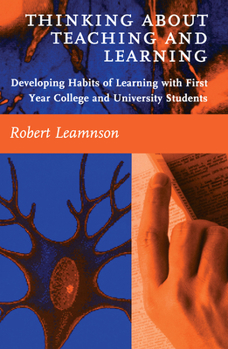Thinking About Teaching and Learning: Developing Habits of Learning with First Year College and University Students
Select Format
Select Condition 
Book Overview
Building on the insights offered by recent discoveries about the biological basis of learning, and on his own thought-provoking definitions of teaching, learning and education, the author proceeds to the practical details of instruction that teachers are most interested in--the things that make or break teaching.
Format:Paperback
Language:English
ISBN:1579220134
ISBN13:9781579220136
Release Date:March 1999
Publisher:Routledge
Length:256 Pages
Weight:0.65 lbs.
Dimensions:0.6" x 6.0" x 9.0"
Customer Reviews
3 ratings
Insightful guide to teaching college students
Published by Thriftbooks.com User , 19 years ago
Leamnson delivers on his title for this marvelous book. Having clearly done a great deal of serious thinking about teaching and learning, he has taken the next step and compared his ideas and experiences with "the experts". The result is a deeply insightful masterpiece.
A Wealth of Good Advice in a Small Package
Published by Thriftbooks.com User , 23 years ago
Thinking About Teaching and Learning deserves a place on every professor's bookshelf. This author approaches college teaching from a basis that is usually ignored by other authors of resource books on college teaching, namely the basis of neuroscience and brain-based concepts about learning. Leamnson is particularly well qualified to produce such a book: his disciplinary training and research is as a biologist, and his experience in teaching spans several decades. Many aspects of instruction are covered, including practices and evaluation, but the consistent thread throughout is how the brain functions in learning. This approach is immensely valuable, because it focuses on the practical and leads the reader toward practices that have firm foundations in research. When one realizes that learning, at the basic level of the brain, involves self-initiated brain changes, it becomes obvious that any teaching practice which fails to emphasize student responsibility is incomplete. When one realizes that new knowledge becomes a part of memory through synapses that are organized then stabilized by use, it reveals that good teaching practices are those that promote and accelerate brain change beyond what a student would likely be able to achieve on his or her own. Based on the concepts given in this book, it becomes obvious why "good practices" such as cooperative learning result in significant increases in learning: time spent in class employing many senses, formulating an understanding and communicating it to be reviewed and discussed by others has the potential to employ more synapses than will taking notes and memorizing words. Effective lessons that promote brain change just don't materialize out of thin air; these require informed planning and an investment of time and hard work by teachers. When "good teaching" is viewed as the practice of creating situations that maximize effective usage of students' brains, it is evident why trendy paradigms which emphasize the value of learning while de-emphasizing the value of teaching should be viewed with healthy suspicion. The author conveys immense respect for both teachers and students and reveals a great awareness that faculty time and student opportunity for learning are assets too important to squander with practices that have no firm foundation. In so doing, the author confronts the meaning and utility of a number of progressive concepts such as passive vs. active learning or learning styles. In so doing, he will cause discomfort for those who are used to parroting popular terms or advocating for progressive practices without having them challenged or subjected to demands for evidence. Here the challenge arises from the very basis of how the brain operates.This is no dry technical book nor is it a prescriptive reference that reduces teaching to employment of a few prescribed pedagogical techniques. Rather, it is an uplifting resource that admonishes the professor to practice in a holistic way: to learn
Practical, Honest, Thoughtful
Published by Thriftbooks.com User , 23 years ago
Experience counts, and this is someone who has spent time in the classroom. I found it a concise, but not superficial, summary of one person's take on higher education teaching. This is not another person with a theory, but someone who integrates several approaches in an informed and practical manner. I'm thinking of sharing this book with some Instructional Technology professors. It is that good.




